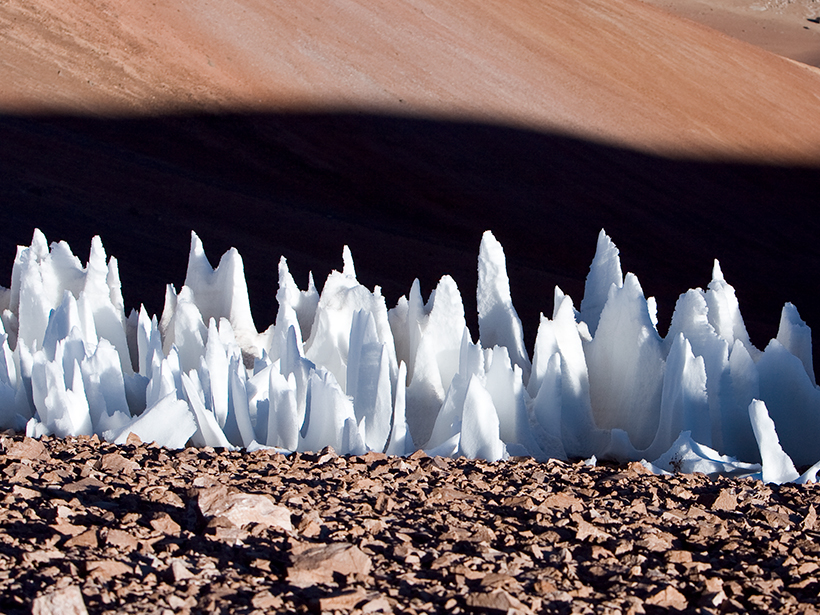Europa, a moon of Jupiter, has long been heralded as one of the most promising places to look for life in the solar system. That’s because it contains an ocean of liquid water beneath its surface that might, much like Earth’s ocean, be a habitable place.
These blades could prevent a lander from exploring parts of Europa.
But now scientists have proposed a potential hitch to safely placing a lander on Europa: Blades of ice up to 15 meters tall might be clustered around the moon’s equatorial region.
These features, which exist in cold, dry areas on Earth and have been spotted on Pluto, are formed when sunlight shines on ice, causing it to completely skip melting into a liquid and instead turning it directly into a gas. Known as “penitentes”—the Spanish term for religious figures kneeling in penance—because of their appearance, these blades could prevent a lander from exploring parts of Europa.
Remarkable Sculpting
Penitentes are found on Earth in cold and dry conditions at tropical latitudes, for example, in the Andes Mountains of northern Chile. They begin to form when a field of ice naturally develops small pits in its surface.
When the Sun is nearly overhead, sunlight preferentially strikes the bottom of these pits, warming the ice. This warming ice doesn’t melt in a traditional sense: The air is so dry that the heated ice immediately gets wicked away into gas in a process called sublimation.
“Over time, the cumulative sublimation eats away at ice, creating penitentes.”
As sublimation continues, the pits deepen. Over time, the cumulative sublimation eats away at ice, creating penitentes with typical heights of 1–5 meters.
Penitentes can last a year or two on Earth, and they’ve even been recreated in laboratory experiments. The New Horizons spacecraft has also spotted these features on Pluto, where they’re believed to be made of towering columns of frozen methane.
Now Jeff Moore, a planetary geologist at NASA Ames Research Center in Moffett Field, Calif., and his colleagues have proposed another location where penitentes might form: Europa.
“The raw ingredients seem to be there,” said Moore. These ingredients include the moon’s icy surface, its cold temperature (between −203°C and −141°C), and the relatively constant angle at which sunlight strikes it.
“We hypothesize that penitentes can grow, and indeed have grown [on Europa],” the researchers wrote in their study, which was published this month in Nature Geoscience.
Towering Tall
Using estimates of noontime temperatures on Europa and the reflectivity of its surface, among other parameters, the researchers estimated that ice on the moon sublimates at a rate of roughly 30 centimeters per million years. That’s millions of times slower than the rate on Earth, mostly because Europa is much farther from the Sun. At the distance of Europa, “the Sun is 25 times less bright,” said Moore.
“The Sun sculpts these special features in a way that is remarkable.”
But even the creeping pace at which ice turns into water vapor on Europa is faster than the rate at which Europa’s surface is eroded by charged particles from Jupiter. And since penitentes form more rapidly than they’re eroded, they should exist on the Jovian moon, the researchers reasoned.
Given that Europa’s surface is about 50 million years old—on the basis of its relative lack of craters—Moore and his colleagues estimated that penitentes as tall as 15 meters might tower over Europa’s equatorial region.
“The Sun sculpts these special features in a way that is remarkable,” said Douglas MacAyeal, a geophysicist at the University of Chicago who was not involved in the research. But remarkable or not, the spires themselves might not be good news. Penitentes would “imply a hazard of attempting to land on an equatorial surface of Europa,” said MacAyeal.
Awaiting a Flyby
Unfortunately, images of Europa taken by spacecraft aren’t detailed enough to reveal or refute the presence of penitentes. However, radar data of the Jovian moon are consistent with penitentes existing near Europa’s equator, Moore and his colleagues noted. Microwave wavelength radar observations of Europa have revealed that its equatorial region tends to reflect less radiation than its higher latitudes. If the moon’s surface were rough near the equator—due to penitentes, for example—that could explain these measurements: The deep pits of these ice blades tend to scatter and absorb radiation.
In the coming decade, NASA’s Europa Clipper mission is expected to put a spacecraft in orbit around Jupiter that will complete flybys of Europa’s surface, and scientists hope that a lander might follow. Moore and his colleagues are looking forward to mining the first data from the Europa Clipper mission, which will skim as close as 25 kilometers above Europa, to look for penitentes.
“If they’re there, we’ll see them,” he said.
—Katherine Kornei (email: [email protected]; @katherinekornei), Freelance Science Journalist
Citation:
Kornei, K. (2018), Huge blades of ice may partially cover Jupiter’s moon Europa, Eos, 99, https://doi.org/10.1029/2018EO108343. Published on 23 October 2018.
Text © 2018. The authors. CC BY-NC-ND 3.0
Except where otherwise noted, images are subject to copyright. Any reuse without express permission from the copyright owner is prohibited.

